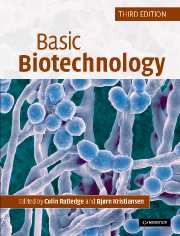Book contents
- Frontmatter
- Contents
- List of contributors
- Preface to the second edition
- Preface to the third edition
- Part I Fundamentals and principles
- Chapter 1 Public perception of biotechnology
- Chapter 2 Biochemistry and physiology of growth and metabolism
- Chapter 3 Stoichiometry and kinetics of microbial growth from a thermodynamic perspective
- Chapter 4 Genome management and analysis: prokaryotes
- Chapter 5 Genetic engineering: yeasts and filamentous fungi
- Chapter 6 Microbial process kinetics
- Chapter 7 Bioreactor design
- Chapter 8 Mass transfer
- Chapter 9 Downstream processing
- Chapter 10 Measurement, monitoring, modelling and control
- Chapter 11 Process economics
- Part II Practical applications
- Index
Chapter 4 - Genome management and analysis: prokaryotes
Published online by Cambridge University Press: 05 June 2012
- Frontmatter
- Contents
- List of contributors
- Preface to the second edition
- Preface to the third edition
- Part I Fundamentals and principles
- Chapter 1 Public perception of biotechnology
- Chapter 2 Biochemistry and physiology of growth and metabolism
- Chapter 3 Stoichiometry and kinetics of microbial growth from a thermodynamic perspective
- Chapter 4 Genome management and analysis: prokaryotes
- Chapter 5 Genetic engineering: yeasts and filamentous fungi
- Chapter 6 Microbial process kinetics
- Chapter 7 Bioreactor design
- Chapter 8 Mass transfer
- Chapter 9 Downstream processing
- Chapter 10 Measurement, monitoring, modelling and control
- Chapter 11 Process economics
- Part II Practical applications
- Index
Summary
Introduction
Gene manipulation is a core technology used for a wide variety of academic and industrial applications. In addition to representing an extremely powerful analytical tool, it can be used to: (i) increase the yield and quality of existing products (e.g. proteins, metabolites or even whole cells); (ii) improve the characteristics of existing products (e.g. via protein engineering); (iii) produce existing products by new routes (e.g. pathway engineering); and (iv) develop novel products not previously found in nature (e.g. directed or hybrid biosynthesis). This chapter assumes knowledge of the basic structure and properties of nucleic acids, the organisation of the genetic information into genes and operons, and the mechanisms by which bacteria transcribe and translate this encoded information to synthesise proteins (see also Chapter 2).
Bacterial chromosomes and natural gene transfer
Bacterial chromosomes
Chromosomes are the principal repositories of the genetic information, the site of gene expression and the vehicle of inheritance. The term chromosome, meaning dark-staining body, was originally applied to the structures visualised in eukaryotic organisms by light microscopy. The use of this term has now been extended to describe the physical structures that encode the genetic (hereditary) information in all organisms. The term genome is used in the more abstract sense to refer to the sum total of the genetic information of an organism. The term nucleoid is applied to a physical entity that can be isolated from a bacterial cell and that contains the chromosome in association with other components including RNA and protein.
- Type
- Chapter
- Information
- Basic Biotechnology , pp. 73 - 118Publisher: Cambridge University PressPrint publication year: 2006



